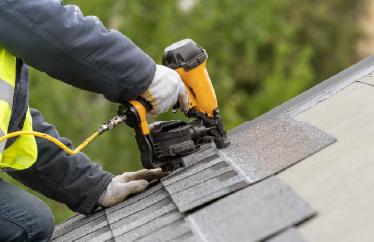Prepare, Don’t Repair: How to Avoid the Most Expensive Home Fixes

Preparing for seasons and fixes will save you $ and time in the future
If you think buying a home is expensive, just wait until you own one. A lot of unexpected costs come up, including expenses tied to home maintenance. 50% of surveyed homeowners in our 2023 Homeowner Preparedness Report said they paid $3,000 or more on repairs in the past year. One thing is for sure: The more effort you put into caring for your home, the less money you’ll spend on costly repairs. Read on and learn more about what you can do to keep your household running smoothly.
Regular inspections
Even when certain items in your home seem to be functioning, it’s important to double-check and make sure there aren’t any issues. Neglected or ignored systems and appliances can cause all sorts of trouble. Sometimes, you can complete a routine check-up on your own. In others cases, you’ll need to bring in the big guns. Here are some of the parts of your home that require regular attention.
Roof: Installing a new roof costs thousands of dollars (although it can lower your insurance premiums). Regular checkups and minor repairs cost a lot less. You should hire a professional to come every three to five years and conduct spot checks yourself every six months. Look for loose shingles, bows or dips and other areas that may indicate that there are leaks or mold growth. Check the inside of your attic, too, and look for stains and damp patches on ceilings and walls.
Chimney: Regularly cleaning your chimney and removing creosote buildup is important if you want to prevent fires from occurring. Once a year — preferably at the beginning of each winter — you should consider hiring a professional to do an inspection. If necessary, they can replace the chimney liner and add caulking or waterproofing materials in places where they’ve withered away to prevent leaks and water damage.
Pipes: Addressing sewage problems can be a nightmare. And following a water line break, you could find yourself shelling out thousands of dollars to deal with the damage. Every year, you or a plumber should check your sewer lines to make sure there aren’t any clogs. Find hidden leaks in your kitchen and bathroom by wrapping paper towels around pipes and looking for wet spots. Leaks can potentially waste gallons of water a year.
Water heater: If your water is discolored or it’s not getting as hot as it used to, you may want to check your water heater. Replacing a defective water heater and cleaning up the damage it caused can set you back by as much as $4,000. Check the pressure valve periodically and flush the tank once a year with a hose. If you hear popping sounds, see puddles or find any other issues, you can hire a plumber or buy your own replacement parts. In total, you could spend anywhere between $150 and $300.
Termites: Termites start from the inside and eat their way out. They usually make their home in wooden frames and drywall, but termites don’t discriminate against flooring, insulation, furniture, carpet, soft metals or household items. The longer they feast on your home, the worse the potential damage. Paying $75 to $150 to have a termite inspector come by is almost always worth it. He’ll check for buckling wood, swollen floors and termite feces. On your own, you can install termite monitors and keep mulch away from your home’s foundation.
Mold: Mold is linked to a number of health issues. It can also significantly decrease your home’s resale value. If you notice a musty odor, suddenly start sneezing or coughing as if you have allergies or see that your walls or ceilings are discolored, it’s best to play it safe. Call someone and find out whether the warning signs you’ve noticed indicate that there’s mold.
It can be very difficult to tell when trouble is brewing. Looking at your roof, chimney and other features in your home every once in a while is a good idea. If you pay attention, you’ll notice that there are often warning signs before something goes wrong.
Preventative measures
Inspections are a great start. They’ll help you keep track of what’s happening at home and reveal what needs to be repaired or changed. There are also preventative moves you can make to keep things running smoothly. Most require cleaning and making small adjustments, so they shouldn’t take more than a few hours. Find out what you can do today to keep your systems and appliances running.
- Replace HVAC filters. Clogged and dirty filters restrict airflow, slow air circulation and reduce the effectiveness of your system. Every one to three months, you should change the filter and do any necessary cleaning.
- Clear gutters. When water gets trapped in places it shouldn’t be in, it can damage your foundation, stain your walls and cause pest infestations. Remove debris and ensure that all downspouts direct water away from your home. If you live in an area with lots of trees, you may have to do this a few times in the fall.
- Preserve the dehumidifier. In addition to keeping the humidistat at an appropriate level (around 35 percent relative humidity), you should clean the water bucket and replace the air filter once a year. While you’re checking in, see if the cooling coils have any frost or ice buildup. This indicates that they may need to be cleaned or replaced.
- Flip the circuit breaker. To prevent corrosion and avoid frequent tripping, you’ll want to flip the circuit breaker manually once a year. You should also consider replacing any two-prong outlets with safer, three-prong outlets to prevent electrical fires and electric shocks.
- Heed weight limits. Most homeowners know to clean their dryer’s lint tray after each use. It’s also important to pay attention to your machine’s weight limits, even if you can cram in more clothes. By stuffing too many shirts, pants and socks in a dryer, it could overheat. You could also end up wasting energy by forcing your dryer to work harder.
- Clean your fridge. Unless you’re mining bitcoin, refrigerators are probably the largest consumer of energy in your home. So it’s important to keep it running efficiently. Many of us wipe down the inside of the fridge in our homes every few weeks. Every six months, you may also want to clean the condenser coils. Replace the gasket as needed and every few years, consider replacing your water dispenser and water filters.
When it comes to home maintenance, it’s tempting to be lazy. But going out of your way to proactively prevent your appliances and systems from breaking down can pay off in more ways than one.CLICK TO TWEET
When it comes to home maintenance, it’s tempting to be lazy. But going out of your way to proactively prevent your appliances and systems from breaking down can pay off in more ways than one. Don’t be penny-wise and dollar-foolish. It’s best to invest a little money and effort into taking care of your home now instead of waiting until it becomes a costly endeavor later. If you’re looking for additional tips, review the owners manuals that you received when you purchased each household item.
Appliance lifespans
Eventually, appliances will need to be replaced. Before you conduct a major repair or pay for an expert inspection, It’s important to consider the age of your appliances. You don’t want to buy a new part for a product you’ll have to replace in a few months.
Knowing the average lifespan of everything from your dryer to your oven will also make it easier to decide whether you should repair or replace an appliance. Dehumidifiers and microwaves can last for nearly a decade while toilets should last a lifetime. Smoke detectors generally last for about 10 years, but it’s important to check them regularly to ensure that they’re in working order. Check out the average lifespan for major appliances.
ApplianceLifespan
AC unit 10 – 15 years
Dishwasher 9 years
Dryer 13 years
Furnace 15 – 20 years
Refrigerator 9 – 13 years
Thermostat 35 years
Washing machine 10 years
Water heater 12 years
Knowing the average lifespan of everything from your dryer to your oven will also make it easier to decide whether you should repair or replace an appliance.CLICK TO TWEET
You can check Consumer Reports for more information. Keep in mind that these are just general guidelines. Some products may last longer than expected while others may break down within weeks. Make and model make a difference but generally, if you take care of your appliances, you’ll be able to use them for years to come.
More protection
As it turns out, the Boy Scouts know what they’re talking about. Preparation is the best way to avoid costly home and appliance issues. Of course, sometimes appliances break no matter how much effort you put into preventing them from falling apart. Plus, things come up that you can’t control, like theft and natural disasters. That’s why it’s important to have insurance.
Before you file a claim, make sure you understand what your policy covers and how the claim will affect the cost of your premiums in the future. In most cases, your homeowners policy can protect you from serious financial losses. Pair that with your own efforts and you should be a very happy homeowner.



